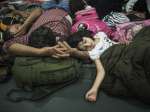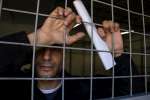Regional Conference on "Refugee Protection and International Migration in the Gulf of Aden"
Migration, 31 May 2008
Conference Binder
The "Regional Conference on Refugee Protection and International Migration in the Gulf of Aden" was held on May 19-20, 2008 in Sana'a, Yemen. It was convened by UNHCR in cooperation with the Mixed Migration Task Force Somalia, an inter-agency coordination mechanism, and with funding from the European Commission. Its principal objective was to contribute to the establishment of a regional medium and longer term plan of action on refugee protection and mixed migration in the Gulf of Aden region. In plenary and in eight different working groups, representatives from both sides of the Gulf of Aden made recommendations on how best to meet these challenges and how cross-regional cooperation could be improved.
Below is a copy of the binder distributed at the conference as well as several documents generated during and after the meeting.
1. MAIN CONFERENCE DOCUMENTS
- 1.1 Conference Agenda
- 1.2 Concept Note: Regional Conference on "Refugee Protection and International Migration in the Gulf of Aden"
- 1.3 Conference Report (including recommendations)
- 1.4 List of Participants
- 1.5 Selected Addresses to the Conference:
- 1.6 Maps of International Migration in the Gulf of Aden Region
2. MIXED MIGRATION TASK FORCE SOMALIA: MIXED MIGRATION THROUGH SOMALIA AND ACROSS THE GULF OF ADEN
3. UNHCR TEN-POINT PLAN ON MIXED MIGRATION AND REFUGEE PROTECTION
- 3.1 UNHCR: Refugee Protection and Mixed Migration: A 10-Point Plan of Action
- 3.2 UNHCR's 10-Point Plan in Central America, Western Africa, Eastern Africa and South Asia – a two year project
- 3.3 UNHCR High Commissioner's Dialogue on Protection Challenges – Theme: Refugee Protection, Durable Solutions and International Migration – Chairman's Summary (December 12, 2007)
4. REFUGEE PROTECTION AND MIXED MIGRATION IN THE GULF OF ADEN REGION: DRAFT STRATEGIES
- 4.1 DJIBOUTI: Implementing the 10-Point Plan of Action
- 4.2 ETHIOPIA: Implementing the 10-Point Plan of Action
- 4.3 SOMALIA: Strategy to Address Mixed Migration Through Somalia
- 4.4 YEMEN: Implementing the 10-Point Plan of Action
5. BACKGROUND INFORMATION ON MIXED MIGRATION
- 5.1 UNHCR DJIBOUTI National Programme: Fact Sheet
- 5.2 UNHCR ETHIOPIA National Programme: Fact Sheet
- 5.3 UNHCR YEMEN National Programme: Fact Sheet
- 5.4 MMTF SOMALI: Fact Sheet on Mixed Migration in Bossaso
- 5.5 Statistical Information on Mixed Migration to Yemen
- 5.6 UNHCR "REFUGEES" Magazine: Refugee or Migrant?: Why it Matters. Number 148, Issue 4, 2007
6. SELECTED LEGAL AND POLICY RESOURCES
International Refugee Law
- 6.1 United Nations Convention Relating to the Status of Refugees (1951) and its Protocol (1967)
- 6.2 OAU Convention Governing Specific Aspects of Refugee Problems in Africa (1969)
International Human Rights Law
- 6.3 United Nations International Convention on the Protection of the Rights of All Migrant Workers and Members of Their Families (1990) (external link)
- 6.4 Convention on the Rights of the Child (1989) (external link)
- 6.5 Convention Against Torture and Other Cruel, Inhuman or Degrading Treatment or Punishment (1984) (external link)
- 6.6 International Covenant on Civil and Political Rights (1966) (external link)
- 6.7 International Covenant on Economic, Social and Cultural Rights (1966) (external link)
- For more information: United Nations Human Rights website.
International Law of the Sea
Regional Migration Law and Policy
- 6.10 Joint Africa-EU Declaration on Migration And Development (2006) (excerpts)
- 6.11 Ouagadougou Action Plan to Combat Trafficking in Human Beings, Especially Women and Children (2006)
- 6.12 African Union (AU) Common Position on Migration and Development (2006) (excerpts)
- 6.13 African Union (AU) Migration Policy Framework for Africa (2006) (excerpts)
- 6.14 League of Arab States: Arab Declaration on International Migration (2006)
- 6.15 Declaration on the Establishment of Intergovernmental Authority on Development (IGAD) Regional Consultative Process (IGAD-RCP) on Migration (2008)
7. MEDIA COVERAGE
- 7.1 Coverage of the Conference in Arab Media
- 7.2 Coverage of the Conference by UNHCR:
Download the collection of conference documents in zipped format for offline browsing and/or printing here: Regional Conference on Refugee Protection and International Migration in the Gulf of Aden [zipped file, 10Mb]
Conference posters: download the conference poster series [zipped file, 9.3Mb]





















































